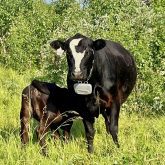CFIA’s current tuberculosis-testing protocol starts with a caudal tail fold (CTF) test, where tuberculin is delivered intradermally into the loose skin along the side of the tailhead.
Seventy-two hours later, the cattle have to be presented again for examination. Animals with suspicious CFT surface reactions have blood taken for a bovigram test.
A positive bovigram leads to a temporary quarantine while animals with positive results are euthanized and inspected for signs of TB. If no lesions are found, the carcasses are cleared and the quarantine is lifted.
Read Also

Body condition, nutrition and vaccination for brood cows
One of the remarkable events of the past century related to ranching has been the genetic evolution of brood cows….
When lesions are found, tissues are stained for microscopic examination. If acid-fast bacilli characteristic of TB are present, tissue samples need to be cultured to confirm the diagnosis. The herd stays in quarantine until the culture results are in, which can take up to four months.
One positive culture means the whole herd must be put down and compensation paid according to CFIA regulations. It’s rare to find more than one to two per cent of a herd infected upon post-slaughter testing.
Trace-outs are conducted to identify animals that have left the herd in the past five years. Those herds are immediately quarantined and the testing process begins again.
A sore point has been the CFIA’s refusal to pay producers a mustering fee for their time and effort rounding up their cattle twice in three days. The provincial government did offer a $6-per-head mustering fee for a few years, then dropped it to $2 and Manitoba Beef Producers kicked in another $1 per head.
New funding for data collection will replace the old mustering fee for producers over the next three years.
















